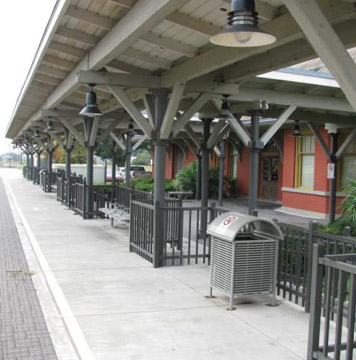Lafayette, LA (LFT)
Seriously damaged in a 2001 fire, the brick depot was subsequently restored by the city to include a transit office and a spacious waiting room for Amtrak and bus passengers.

100 Lee Avenue
Lafayette, LA 70501-8032
Annual Station Ridership (FY 2024): 4,493
- Facility Ownership: City of Lafayette
- Parking Lot Ownership: City of Lafayette
- Platform Ownership: BNSF Railway
- Track Ownership: BNSF Railway
Todd Stennis
Regional Contact
governmentaffairsnol@amtrak.com
For information about Amtrak fares and schedules, please visit Amtrak.com or call 1-800-USA-RAIL (1-800-872-7245).
The Lafayette train station is a brick structure originally constructed by the Texas & New Orleans Railroad. A plaque in the station states that this historic depot was built in 1911, although some contend it was built in 1912. The depot burned in a fire on May 11, 2001 and was left abandoned until 2002 when restoration began. Today, the station has been transformed into a modern transportation facility, while simultaneously preserving the history of the train depot. Prior to the fire, the station was already dilapidated, and plans to refurbish the historic building as the first stage of a larger project for a multimodal facility had already begun.
The city of Lafayette uses the building as a city transit office, a waiting room for city bus and Amtrak passengers, an intercity bus station, and the city-parish Traffic and Transportation Department. The large-scale renovation, an $11 million project, has preserved the history of the building by restoring it to its original appearance. The project included railroad trackside improvements along with the enhancement of the depot.
While some suggested tearing the original structure down and starting fresh, the community insisted the old building remain, as it is one of the few structures that have remained the same since its construction in the early 20th century. The intention of the project thus became to ensure the preservation of the building’s history. The renovation restored the original walls of the depot as well as the canopy and the elaborate posts that support it and the new station features the history of the railroad. A pedestrian gateway leading up to the buildings showcases the flags of Lafayette’s sister cities around the world, and the surrounding parking lots mirror the streetscape project on Jefferson Street.
The ambitious project, which was in the planning stages for 10 years and was finally completed in 2007, was funded by the local government, the Federal Transit Administration, and the Louisiana Department of Transportation and Development. The multi-modal transportation center was named the Rosa Parks Transportation Center upon its completion.
The city of Lafayette is full of culture, probably due to the mélange of people who have settled there. Lafayette’s cultural influences include Native American, French, Spanish, African American, and English. The earliest settlers were the Attakapas Indians, whose burial mounds still exist along the Vermilion River and Bayou Teche. The area was sparsely settled by Europeans until 1765, when the Acadians began arriving in New Orleans. The Spanish governor granted them land in the Lafayette area. In 1821, the city that would become Lafayette was laid out by French Acadian Jean Mouton and named “St. Jean du Vermilionville,” eventually shortened to Vermilionville. The parish name (Louisiana is the only state to have parishes, rather than counties) became Lafayette in 1823 when French General Lafayette visited the United States. In 1884, the city was renamed Lafayette as well.
Lafayette is generally acknowledged as the capital of Acadiana. It is full of cultural attractions which include the Acadiana Center for the Arts, Acadian Village, Jean Lafitte Acadian Cultural Center, the Lafayette Natural History Museum & Planetarium, the National Wetlands Research Center, and the second largest Mardi Gras celebration in Louisiana.
Founded in 1900 as an industrial institute, the University of Louisiana at Lafayette is a coeducational public research university and is the largest campus within the eight-campus University of Louisiana System. With more than 17,000 students, it is the second largest university in the state and the home of the Rajin’ Cajuns, who play at the Cajundome.
Station Building (with waiting room)
Features
- ATM not available
- No elevator
- No payphones
- No Quik-Trak kiosks
- No Restrooms
- Unaccompanied child travel not allowed
- Vending machines
- No WiFi
- Arrive at least 30 minutes prior to departure
Baggage
- Amtrak Express shipping not available
- No checked baggage service
- No checked baggage storage
- Bike boxes not available
- No baggage carts
- Ski bags not available
- No bag storage
- Shipping boxes not available
- No baggage assistance
Parking
- Same-day parking is not available
- Overnight parking is not available
Accessibility
- No payphones
- Accessible platform
- No accessible restrooms
- No accessible ticket office
- Accessible waiting room
- No accessible water fountain
- Same-day, accessible parking is not available
- Overnight, accessible parking is not available
- No high platform
- No wheelchair
- No wheelchair lift
Hours


 Amtrak established the Great American Stations Project in 2006 to educate communities on the benefits of redeveloping train stations, offer tools to community leaders to preserve their stations, and provide the appropriate Amtrak resources.
Amtrak established the Great American Stations Project in 2006 to educate communities on the benefits of redeveloping train stations, offer tools to community leaders to preserve their stations, and provide the appropriate Amtrak resources. Amtrak is seizing a once-in-a-lifetime opportunity to transform rail and Retrain Travel. By modernizing, enhancing and expanding trains, stations and infrastructure, Amtrak is meeting the rising demand for train travel. Amtrak offers unforgettable experiences to more than 500 destinations across 46 states and parts of Canada. Learn more at
Amtrak is seizing a once-in-a-lifetime opportunity to transform rail and Retrain Travel. By modernizing, enhancing and expanding trains, stations and infrastructure, Amtrak is meeting the rising demand for train travel. Amtrak offers unforgettable experiences to more than 500 destinations across 46 states and parts of Canada. Learn more at